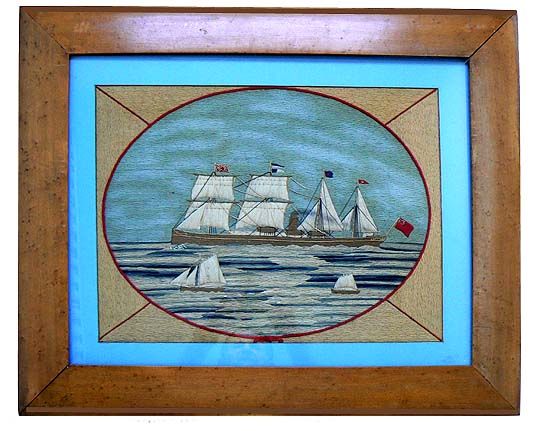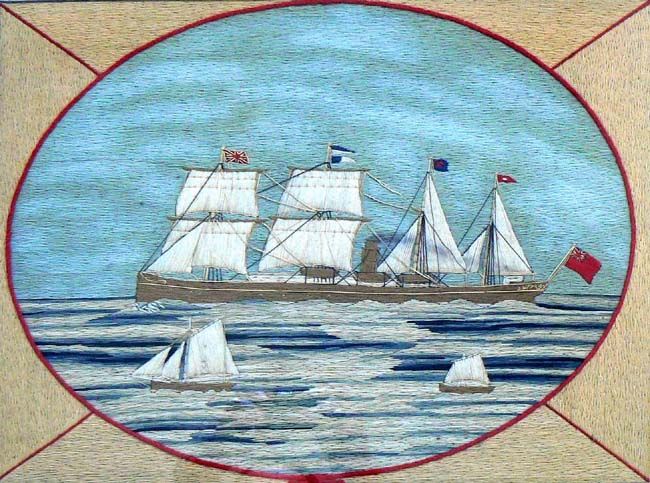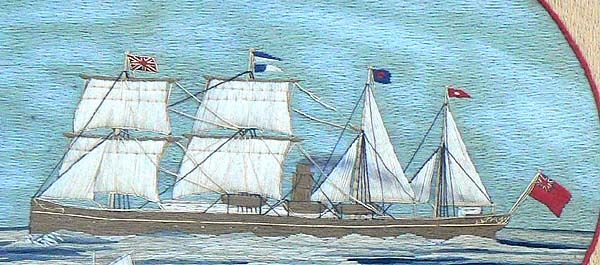Wool Work of Sail Assisted 4 Masted British Steamship
Ca. Mid 19th Century

PICTURE SIZE: Unframed 19 1/4”x 14 1/2″,
viewing area Framed 29“ x 24“
Original Price: $3200.00 Sale Price: $1500.00
Shipping: $85.00
Presented
is an exceptionally well-made wool work, often referred to as a woolly, of an early British steam merchant ship assisted by sails on four masts. The forward two masts are square-rigged, and the aft two are fore and aft-rigged. It is in exceptional condition. The ship has no bowsprit, which tells us the time is about 1875, fifteen years after the sailing vessel hit its high point. She flies the Union Jack or Red Duster from her stern and a modified version with a white border from her foremast. This indicates she has called for a pilot to help her enter port. Of the two small sailing vessels to her port side, the lead one might be the Pilot boat.

Note the intricate scrollwork on the ship’s
bow and stern. This is a not often seen embellishment. The work has a complex stitched mat in a light tan/grey with
red detail, adding a formal look to the ship. The small stitches are worked in shades of blue, black, white, tan, and red.
Some are faded with age, such as the ship’s hull, which was likely black originally. This adds to the picture’s charm. All the
stitching is intact, and there is no evidence of damage. The picture was taken under glass using incandescent lighting. In
some photos, the colors may be brighter than when viewed in daylight.

MEANING OF FLAGS: The Union Jack with the
white border on the foremast truck was authorized for use in 1823 to call for a ship’s pilot and was known as a Pilot Jack.
The flag on the mainmast truck is generally the “house” flag, which signifies the vessel’s owner. It is usually in the
shape of a rectangle or a swallowtail pennant. The flags shown are pennant style. The shape of the flag on the third mast
looks like a house flag, and the one on the last or mizzen mast might be a Royal Navy Reserve status flag. The flag on the
staff at the stern shows the vessel’s British nationality, dating from 1801.

CONDITION: The woolie is in excellent condition. There
are few, if any, broken threads, and there are no moth holes or water staining. All stitches are tight. The colors are faded
in places, such as the ship’s hull and the border. Somewhere in the past, it was removed from a stretcher and mounted on cardboard.
The small pilot boat shows a slight imperfection on its mainsail.
A SIMPLE CHECKLIST FOR BUYING WOOLIES
Condition is the
a most important consideration. Are the threads intact, stretched, water-stained, moth-eaten, etc.? Expect to see some
fading of color, which is a good indication of age. Bright, vibrant colors
may be the sign of a recently made piece, but it also could be that of one stored away or out of the sunlight, which
would be a good thing. The complexity of design: Woolies
with more than a simple ship profile are more valuable. Some have land in the background, the name of the vessel,
various flags flying, crests, or other embellishments that add value. Design: Some sailors had a
knack for composition and color sense, which made the work visually appealing, while others ended with an unattractive scene
. The larger the size,
the higher the value. Most woolies are about 16 x 24 inches. Stitching: There are various
stitches that sailors used, many of which came from sail making, but others learned the art of embroidery, so they combined
complex stitches for detailing. This adds value. Long stitches take less time; therefore, closely spaced stitches add value. If nothing else, remember CONDITION, COMPOSITION, and COMPLEXITY enhance the value
HISTORY: British sailors crafting
woolies were talented needleworkers. The height of popularity of this form of folk art was between 1840-1880. The sailors
learned their craft through their daily routines of repairing the ship’s sails and taking care of their uniforms. They made
the most of their limited spare time and personal space by creating works of art that could be rolled up and stored under
their bunks when not being worked on. These sailors were knowledgeable about their ships and their surroundings. They were skilled
at drawing on canvas and transforming a simple sketch into a vibrant, detailed, and interesting ship picture. Their accomplishments
are magnified by being self-taught and creating their works for the satisfaction they gave since there was no profit motive.
The overwhelming majority of woolies are unsigned. Gallery prices for works such as this can range from a low of $4000.00
to a high of $35,000.00 on average..
